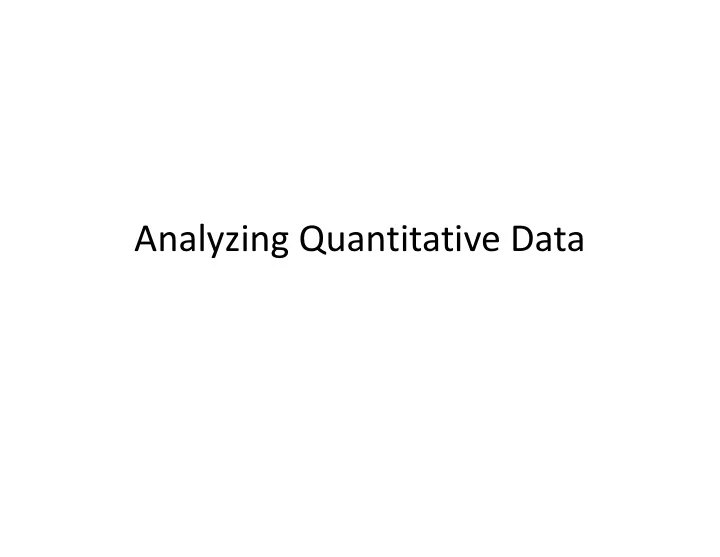

Analyzing Quantitative Data
Analysis is about QUESTIONS • Does physical vs soft keyboard, known vs unknown language affect typing speed or error rate? • Hypotheses?
Analysis
Analysis (2)
Analysis (3)
Analysis (2)
Results
Univariate Tests
Summary Tables
So … Multivariate or Univariate • You can look at your design from a multivariate point of view if you regard your data not as representing realisations of one DV in different conditions, but of (ultimately) different DVs which are to be analysed simultaneously. http://stats.stackexchange.com/questions/4530/when-to-interpret-multivariate-tests-when-performing-repeated-measures-ancova –
Also gives estimates of performance for each iv
Also gives estimates of performance for each iv
Another Interesting Effect: Tripling Data
Another Interesting Effect: Tripling Data
Analysis is about QUESTIONS • Does physical vs soft keyboard, known vs unknown language affect typing speed or error rate? • Hypotheses? • OTHER QUESTIONS?
Examples of other questions • Correlation Questions – Does physical keyboard speed correlate with soft keyboard typing speeds? – Does error rate correlate on physical vs soft keyboards? • Likert/Preference/Rating Questions – Preferences for physical vs soft keyboards? – Perceived efficacy of soft keyboards? – Perceived performance of soft keyboard for known vs unknown language • Cognitive workload questions – NASA TLS evaluation of soft vs physical keyboards?
Data Types Categorical • – Technical discipline, Y/N – Gender, M/F Ordinal • Categorical – Orderable but not equidistant values – Likert data is a good example Strongly agree, agree, neutral, disagree, strongly disagree • – Education Level (high school, some university, undergrad, grad). Interval • – Equidistant values, but values are not based upon a 0. – Can’t really say “twice as X”. – Evaluate the software: Hated it = -3; Loved it = 3. Continuous Ratio • – Speed: Twice as fast – Years of education: 2X the years of education. – Errors: Double the errors
Correct Test for Correct Data/Questions • Does physical vs soft keyboard, known vs unknown language affect typing speed or error rate? • Does physical keyboard speed correlate with soft keyboard typing speeds?
A Note on Likert (and Other) Ordinal Data • Likert Data – Mann-Whitney U-Test This test is used when we obtain ordinal data in the independent groups situation. – Wilcoxon Signed-Ranks Test This test is used when we obtain ordinal data in the paired samples situation.
Question • Does physical vs soft correlate?
Question • Does physical vs soft correlate?
Question • Does physical vs soft correlate?
Correlations 1 1 3 v ( s ) w ( s ) r ( s ) = ⋅ ′ b
Models and Correlation Touch Mouse
Analysis? Paths r p Intercept Slope All .55 <.0001 8.35 1.18 Unidir Last .56 <.0001 7.73 1.18 All .37 <.0001 28.23 .39 Circular Last .33 <.0001 27.11 .40 Paths r p Intercept Slope All .63 <.0001 4.17 .98 Unidir Last .64 <.0001 4.53 .95 All .39 <.0001 10.6 .56 Circular Last .41 <.0001 10.3 .57 What about nice Fitts’s Law correlation?
Averaging • Averaging serves a highly valuable purpose; when curves are averaged, factors including naturally occurring neurophysiological noise, errors (overshoot, undershoot and target misses), and cognitive variations such as response bias [14] that are present in any one sample are eliminated. What remains is the expected performance value for a task, i.e. the average cost given a large number of iterations. The higher the correlation coefficient for average input time, the more encompassing the model.
Analysis Touch Mouse Filter r 2 r 2 p p All .94 <.0001 .98 <.0001 Unidir Last .93 <.0001 .97 <.0001 All .87 <.001 .90 <.0001 Circular Last .89 <.001 .92 <.0001
Recommend
More recommend